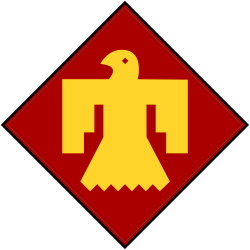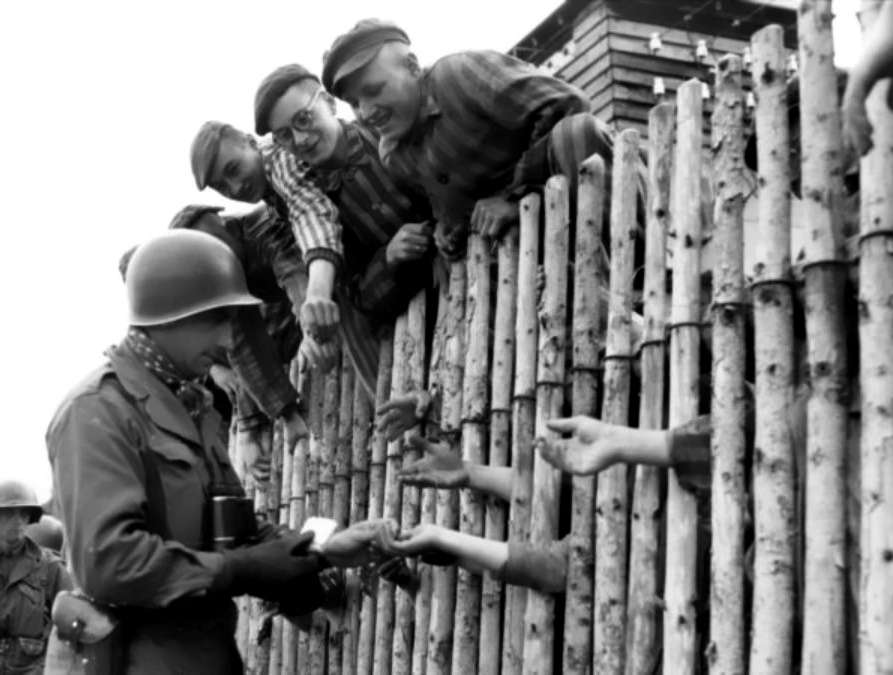By this time, the square was completely filled with thousands of yelling, screaming people. They were all crowded up to the edge of a ditch just inside the barbed wire fence enclosing the encampment. Gen Linden arrived at the gate just as several of the people threw themselves across the ditch and onto the barbed wire. The wire was charged with electricity and those on the wire died instantly. Lt Cowling personally saw three of them die this way. By this time, several inmates of the camp infected with typhus, lice, and other diseases had managed to hoist themselves up to the windows of the guardhouse and were pouring out of those doors. Gen Linden directed his guards to get the people and personally pushed a number of them back into the enclosure.
 Lt Cowling went back into the guardhouse, got the eight German prisoners, brought them outside, and took them to the opposite side of the moat. About this time Col Fellenz of the 1/222-IR (42-ID) arrived with several of his men. There were also some members of the 45-ID present. German guards still remained in all of the towers surrounding the prison, with the exception of the one previously mentioned and two right at the gate.
Lt Cowling went back into the guardhouse, got the eight German prisoners, brought them outside, and took them to the opposite side of the moat. About this time Col Fellenz of the 1/222-IR (42-ID) arrived with several of his men. There were also some members of the 45-ID present. German guards still remained in all of the towers surrounding the prison, with the exception of the one previously mentioned and two right at the gate.
As some of the men of Col Fellenz’s battalion and some of the men of the 45-ID approached one of the towers, some of the guards fired into the crowd which was attempting to break through the fence. The doughboys of the two infantry divisions shot the SS guards who had commenced the prison. In the meantime an officer of Col Fellenz’s battalion had cut the switch which charged the fence surrounding the prison, to prevent any more of the half-crazed inmates from dying from its electric charge.
There was still considerable disorder at this time and large numbers of prisoners were attempting to climb over the fence or come through the gates. A few American soldiers had a good deal of difficulty in attempting to make the prisoners, who were of all nationalities, understand that they must remain inside the enclosure until the Americans could arrange proper facilities for release. In one or two instances it was necessary for officers to give orders for the men to fire over the heads of the inmates to gain their attention and get them back inside the enclosure.
In one instance, just as the prisoners were pushed back inside the enclosure, an enlisted man of the 45-ID picked up a number of chains, shackles, etc. which had been used to chain the prisoners, and he rattled them at the crowd. Gen Linden ordered the man, who was standing directly in front of him, to drop the chain at once as they were causing increased excitement among the prisoners and they were surging forward in an attempt to get through and grab the chains and again break out of the confines of the enclosure. The man, however, disobeyed Gen Linden’s order and turned his back on him, raising the chains above his head and shaking them again. In an attempt to get the man’s attention, Gen Linden tapped the man on the helmet with a stick he was carrying. The man turned and the Gen again directed him to drop his chains. This time the man dropped the chains and walked off, although he was very sullen, showing no military discipline or respect.
The sight of the chains had made the crowd again surge forward and some of them were again streaming through the gate. It was impossible to hear above the noise and hub-bub. Gen Linden ordered the men back at the point of his pistol and a captain of the 222-IR fired his rifle into the air to get their attention. The men again were pushed back inside the enclosure and a semblance of order was restored, although it was necessary for the next hour or so to continue a close vigilance to keep members of the crowd from breaking through the fence and out of the enclosure.
The next hour was spent by Gen Linden and his group, including Col Fellenz with some elements of his battalion and a Col Sprague of the 45-ID also with some of his men, in attempting to calm the crowd and make them realize they would have to remain in the prison until they could get proper food and medical attention, deloused, etc. A major of the American army who was a prisoner of the camp and a lieutenant commander of the British navy, a Canadian officer and a Belgian officer volunteered their services in setting up a committee among the prisoners themselves to help in restoring order and organizing the camp in preparation for the release of its prisoners. Finally, with the aid of these peoples, the crowd was calmed down and order was restored.
An Associated Press reporter and another reporter requested permission from Gen Linden to go through the camp on an inspection. Linden consented and offered to accompany the two reporters. Lt Cowling and one of the guards went through with Gen Linden and the two reporters. The major who had been a prisoner provided a guard for the party.
The first place the group visited was a large yard in which piles of assorted clothing were stacked. In one pile were shoes, in other pants, and so on. We were then shown a room which looked something similar to a reception room, and off it was another room with the marking ‘Showers’ on it. Actually it was a gas chamber used by the Germans to kill the prisoners.
The camp also contained four large ovens in which the bodies were cremated. As the group moved through the camp the prisoners moved to either side to make a pathway, but many reached out to touch the Americans’ clothing or to attempt to shake our hands. Many of them were crying and they were all shouting and yelling. The guide took the group to numerous piles of bodies that were stacked between the various buildings throughout the camp. These bodies were in piles of anywhere from 2 to 50.
All of the bodies showed signs of starvation and were mere skeletons, and many of them showed signs of beating. The barracks were dirty, low, squat buildings with bunks stacked to the ceiling, four high, and so close together that a man could hardly squeeze between them, and in many cases probably had to crawl over them to get into them. In one building the people were all typhus cases and many of them lay on the bare floor, while a few had dirty straw pallets. The men tried to raise up and smile at the Americans or wave at them, but most of them were too weak to do more than look in their direction.
The party then returned to the outside of the enclosure. By this time order was restored; the German guards had either been killed or taken prisoner and the Americans had taken over the camp. Gen Linden and the rest of his party then left the camp and returned to the 222-IR CP.
Gen Linden returned to the camp a short time later to be certain that it was well under control and that things were going smoothly. The 42-ID was given the responsibility of the 32-odd prisoners inside the enclosure and the 45-ID to take care of the buildings on the ground outside the enclosure. Gen Linden remained there until he was certain that Col Fellenz had things well in hand and then left, the time being approximately 2130 and returned to the 222-IR CP and from there went back to the Division CP.
WILLIAM J. COWLING III
1st Lt., ADC Aide to Asst. Div. Comdr.

















